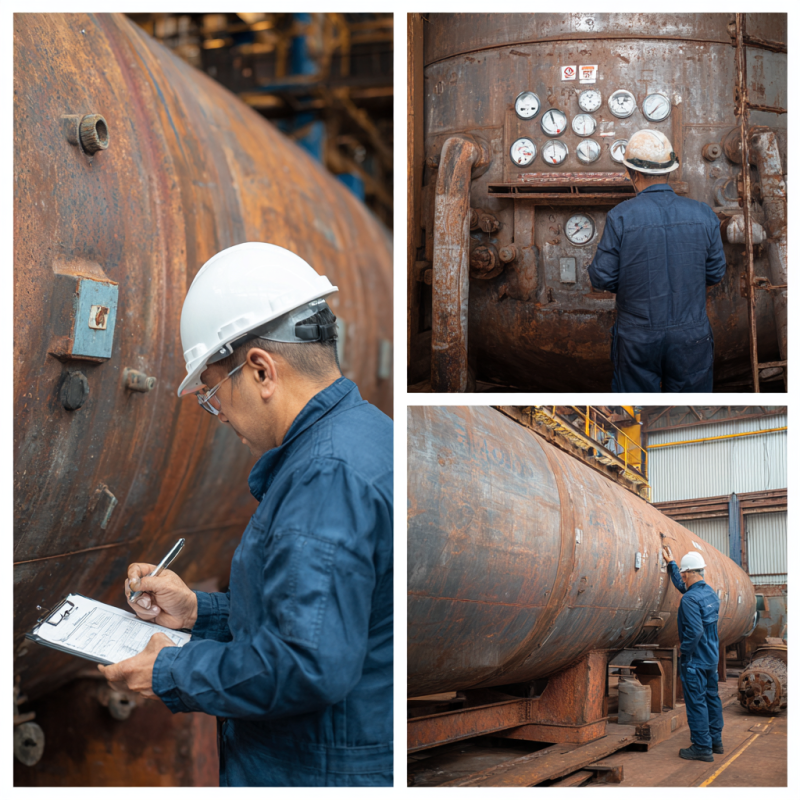
What Is Pressure Vessel Inspections? The Importance of Regular Inspections
What Is Pressure Vessel Inspections?
What is pressure vessel inspections? Pressure vessel inspections are essential for maintaining safety, integrity, and compliance with industry regulations. These inspections are critical in identifying potential hazards before they become serious threats. What is pressure vessel inspections and why is it so important? Regular inspections not only help extend the life of your equipment but also reduce the risk of catastrophic failure. The importance of pressure vessel inspections can’t be overstated when it comes to protecting your assets and workforce. Explore our pressure vessels solutions to learn more about how we prioritize safety.
The Importance of Pressure Vessel Inspections
Understanding what is pressure vessel inspections is key to maintaining operational safety. Regularly checking pressure vessels helps to identify defects early and prevent costly breakdowns or safety incidents. Pressure vessels operate under extreme conditions, and even small issues can escalate into major hazards. Ensuring these vessels are regularly inspected protects not only the equipment but also the personnel and the environment. Learn more about how our solutions for pressure vessels prioritize long-term safety and compliance.
Why Carry Out Pressure Vessel Inspections?
Preventing Catastrophic Failures
What is pressure vessel inspections all about? It’s a crucial step to prevent catastrophic failures that can cause significant damage to equipment and risk to life. Pressure vessels are designed to withstand high pressures, but if they are not regularly inspected, cracks, corrosion, or other defects can lead to disastrous results. By conducting regular inspections, you can detect these issues early and mitigate risks. Learn more about our inspection processes.
Ensuring Compliance with Regulations and Standards
Regular pressure vessel inspections help ensure compliance with industry standards such as the ASME Boiler and Pressure Vessel Code. Non-compliance can result in penalties and operational shutdowns. Understanding what is pressure vessel inspections is not only a safety measure but also a regulatory requirement for many industries. See our ASME-certified pressure vessels for assured compliance with all standards.
Extending Service Life and Reducing Downtime
By performing pressure vessel inspections, you can identify small issues before they turn into major problems, extending the lifespan of your equipment. Inspections help avoid costly repairs and unplanned downtime, which can significantly impact operations. Preventing failures before they happen is a key part of maintaining a smooth, efficient operation. Explore our services that minimize downtime.
Enhancing Operational Safety and Risk Management
What is pressure vessel inspections? It’s an important component of a broader safety and risk management strategy. These inspections help identify hidden risks and ensure that pressure vessels operate within safe parameters. By enhancing safety measures, you reduce the risk of accidents and improve overall operational efficiency. Discover how we can help you improve safety.
Protecting the Environment
Regular pressure vessel inspections also reduce the likelihood of environmental damage. A failure in a pressure vessel could lead to the release of hazardous materials into the environment, causing pollution or even a disaster. Inspections help prevent such events, ensuring that your operations remain environmentally responsible. Read more about our commitment to protecting your facility.
Who Carries Out Pressure Vessel Inspections?
Pressure vessel inspections must be carried out by qualified professionals who are familiar with the equipment’s operation and the regulatory standards. Certified inspectors use specialized tools to evaluate the pressure vessel’s condition. These professionals follow established procedures to detect any issues before they escalate. If you’re looking for reliable inspection services, we offer high-quality pressure vessel inspections to meet your needs.
Types of Pressure Vessel Testing
Visual Inspection
The first step in pressure vessel inspections is typically a visual inspection. Inspectors will examine the exterior for signs of damage, corrosion, or leaks. Learn more about our inspection processes.
Ultrasonic Testing
Ultrasonic testing uses sound waves to detect cracks and other internal flaws within the vessel. This testing method is highly effective for identifying issues that may not be visible on the surface.
Magnetic Particle Testing
Magnetic particle testing is used to identify surface and subsurface cracks in ferrous materials. This method is particularly useful for inspecting pressure vessels that are exposed to high stresses during operation.
Radiographic Testing
Radiographic testing involves using X-rays to look for internal defects that can affect the vessel’s integrity. It is a precise method to identify flaws that can go undetected by other means.
Eddy Current Testing
Eddy current testing uses electromagnetic fields to detect cracks or material changes in a pressure vessel. This testing method is non-invasive and provides a clear picture of the vessel’s condition.
How Often Should a Pressure Vessel Be Tested?
Initial Testing
Initial pressure vessel inspection is conducted before a new vessel enters service. This inspection ensures that the vessel meets the required safety and performance standards before it is used.
Periodic Inspection
Once a vessel is operational, it must undergo periodic inspections to monitor its ongoing condition. The frequency of these inspections depends on the operational environment and the vessel’s history.
Risk-Based Inspection
Risk-based inspections prioritize testing for vessels that are at higher risk of failure. This approach is based on the vessel’s age, operational conditions, and criticality within the process.
In-Service Conditions
Pressure vessels that operate in harsh or extreme conditions require more frequent inspections to ensure they remain in safe working condition.
Pressure Vessel Inspections: Safety and Integrity
Pressure vessel inspections ensure the safety and integrity of your equipment. They help identify any weaknesses that could lead to system failures. Regular inspections are a key safety measure that ensures your pressure vessels perform as intended, minimizing risks for both your team and the environment. Read more about our pressure vessel solutions.
Pressure Vessel Inspection: Learn the Best Practices
To maximize the effectiveness of pressure vessel inspections, it’s essential to follow best practices. These include using the right inspection techniques, maintaining accurate records, and ensuring that all necessary tests are conducted at the appropriate intervals. By implementing best practices, you ensure that your inspections are thorough and accurate. Learn more about our pressure vessel inspection services.
What Is Pressure Vessel Inspection?
In essence, pressure vessel inspections are conducted to evaluate the structural integrity and operational safety of the vessels. These inspections are necessary to detect issues like corrosion, cracks, or leaks, ensuring that the vessels function safely and efficiently. Explore our pressure vessel solutions to learn more about how we ensure the safety and longevity of your equipment.
How Often Should You Inspect Pressure Vessels?
Inspection frequency depends on several factors:
- Operating Conditions: Vessels under extreme temperatures, pressure, or corrosive environments need more frequent checks.
- Regulatory Compliance: Regular inspections are required by local and international regulations to avoid penalties or shutdowns.
- Vessel History: Older or heavily used vessels need more frequent inspections to ensure continued safety.
What is Pressure Vessel Inspections: Why Regular Inspections Matter
Understanding what is pressure vessel inspections is crucial for ensuring the safety and operational efficiency of your equipment. Regular inspections are not just about compliance but also about protecting your team, assets, and the environment. By adhering to the best practices for pressure vessel inspections, you can reduce the risk of catastrophic failures, extend the service life of your vessels, and ensure a safer workplace. Contact us for pressure vessel inspection services to learn more about how we can help you keep your equipment safe.
Need a reliable partner?
Red River specializes in the design and manufacturing of pressure vessels. We also fabricate related items such as prefabricated spools and skid packages.
Reach out to us today and experience the Red River difference. Where American-made products and American Values come together, we care more.
Frequently Asked Questions
1. What is pressure vessel safety?
Pressure vessel safety involves proper design, inspections, safety devices, training, and code compliance to prevent failures and protect lives.
2. What are Pressure Vessel Safety Standards?
Pressure vessel safety standards set minimum requirements for design, fabrication, inspection, and operation. Standards like ASME BPVC, EN 13445, and JIS B8265 ensure safety, compliance, and accident prevention through proven engineering practices.
3. Are there non-intrusive methods for pressure vessel inspection?
Yes, non-intrusive methods such as ultrasonic testing and radiographic testing can be used to assess the internal condition of a pressure vessel without disassembling it.
4. How frequently should I inspect my pressure vessel?
Pressure vessel inspection frequency depends on age, operating conditions, and criticality. Consult guidelines or a certified inspector for a tailored schedule.
5. What should I do if an inspection reveals defects in my pressure vessel?
If an inspection reveals defects, immediate action should be taken to address the issues, either through repair, replacement, or further testing. Failure to act could result in system failure and safety risks.
Key Takeaways
- Pressure vessel inspections are essential for ensuring the safety, longevity, and efficiency of your equipment.
- Regular inspections help detect issues early, preventing catastrophic failures and reducing downtime.
- Adhering to safety regulations and standards ensures compliance and protects your company from legal consequences.
- Inspections should be conducted by certified professionals using appropriate testing methods for optimal results.
